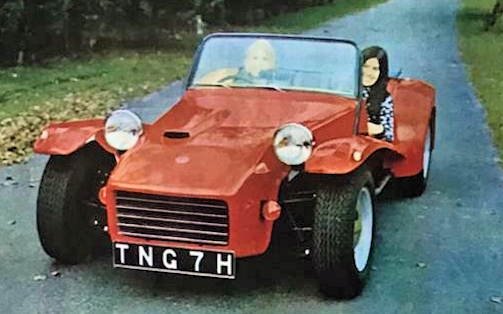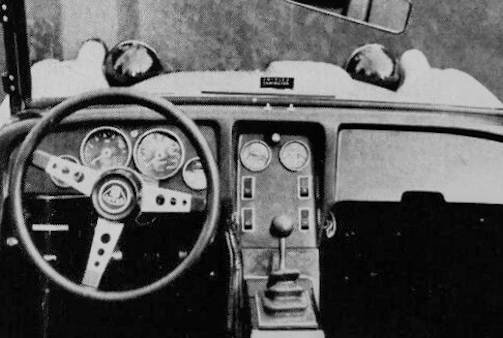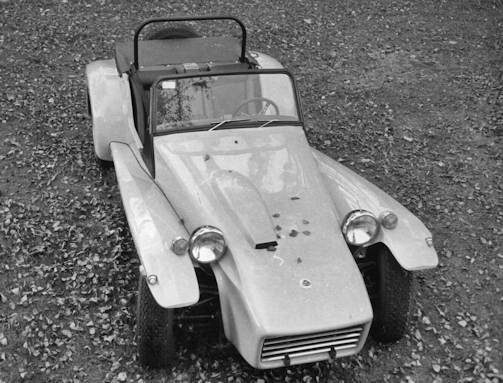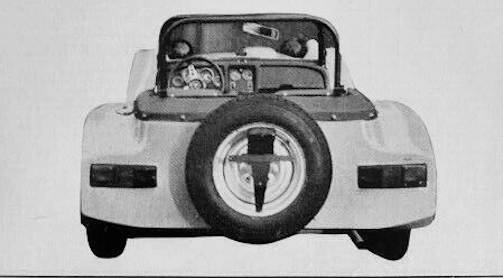Lotus Seven
| 1970 to 1972 | |
|---|---|
 |
|
| Overview | |
| Manufacturer | Lotus Cars |
| Class | Sports car |
| Production | 1970 to 1972 |
| Assembly | Hethel, Norfolk, England, United Kingdom,Martínez, Argentina |
| Designer | Colin Chapman |
| Body and chassis | |
| Class | Sports car |
| Body style | roadster |
| Layout | FMR layout |
| wheel base | 90 in, 1,286 mm |
| overall length | 146.30 in, 3,716 mm |
| overall width | 60.50 in, 1,537 mm |
| dry weight | 1,310 1b, 594 kg |
The Lotus Seven Series 4 is a small, simple, lightweight two-seater open-top sports car produced by Lotus Cars In 1970, Lotus changed the design of the car significantly; The result was the somewhat more conventionally proportioned Series 4 (S4) with a more angular GRP body, which largely replaced the previous aluminum structure.
History
The Lotus Seven was launched in 1957 after the Lotus Eleven had already been produced in limited numbers. With the Series 4, the Seven also offered standard comfort features such as a fan heater for the first time. However, the S4 model was not well received and Lotus only sold a few copies.
BODY: roadster in plastic material; no doors; seats: 2. Tubular chassis with fabricated front and steel side panels. Glass fibre body shell doubleskinned at sides fully weather proofed. Handmade Chassis: Front suspension: Trapezoidal Wishbone with coil springs and internal telescopic shock absorbers, rear rigid axle with coil springs and Inside. Telescopic shock absorbers. deformable steering column.
Interior:Smiths instruments internally illuminated black chrome bezels 2 adjustable bucket seats upholstered imitation leather upholstered, whole interior upholstered in black, three-spoke leather steering wheel,short gear stick on center console, fan heaters, ashtrays,instruments for tank capacity, water temperature and oil pressure, ammeter, Tachometer and speedometer center panel With ammeter fuel gauge switches and Headlamps. heater.

(Optional)
ENGINE (Lotus Twin Cam) max power (DIN) 115 hp.
ENGINE (Lotus-Holbay Clubman) max power (DIN) 120 hp.
Optional Extras tonneau cover. alloy wheels: roll bar, carpet kit,tool kit and hazzad flashers.
Versions
- First generation Production 1957–1960.
- Second generation Production 1961–1967.
- Third generation Production 1968–1969.
- Fourth generation Production 1970–1972.
The tax system of the time ( purchase tax , consumption tax) enabled the car to be sold more cheaply by offering it as a kit car , as this eliminates the tax surcharge that would have been incurred on fully assembled vehicles. However, the tax laws stated that no building instructions could be enclosed with the kits. However, Lotus took advantage of a loophole in the legal text and provided customers with dismantling instructions that only had to be followed in reverse order to assemble the vehicle. With the accession of the United Kingdom to the EEC on January 1, 1973, the British government had to pass consumption tax through VAT substitute. This eliminated the tax advantages and the Lotus Seven kit vehicles came to an end.
In 1973, Lotus decided to completely abandon the “kit car image” and instead concentrate on limited-edition racing and sports cars. Lotus therefore sold the production rights of the Seven to their last remaining dealer, Caterham Cars . After the Caterham company continued to produce the Series 4 for a short time (including the assembly of remaining Lotus kits), they introduced their version of the Series 3 model. Since then, it has been produced as Caterham Seven and is constantly being revised. In addition, many other companies have been found that follow the idea of the small, light sports car and offer very similar vehicles.
The British tax system of the time (Purchase Tax) meant the car could be supplied as a kit (known as "completely knocked down" or CKD) without attracting the tax surcharge that would apply if sold in assembled form. Tax rules specified assembly instructions could not be included, but as the rules said nothing about the inclusion of disassembly instructions, they were included instead and all the enthusiast had to do was to follow them in reverse.

Having joined the EEC on 1 January 1973, the UK had to abolish Purchase Tax and adopt VAT instead. VAT does not allow for concessions such as "CKD", so the tax advantage of the kit-built Lotus Seven came to an end.
In 1973, Lotus decided to shed fully its "British tax system"-inspired kit car image and concentrate on limited series motor racing cars. As part of this plan, it sold the rights to the Seven to its only remaining agents Caterham Cars in England and Steel Brothers Limited in New Zealand. Caterham ran out of the Lotus Series 4 kits in the early 70s. When this occurred and in accordance with their agreement with Lotus, Caterham introduced its own brand version of the Series 3. They have been manufacturing and refining this car ever since as the Caterham Seven.
Steel Brothers Limited in Christchurch, New Zealand assembled Lotus Seven Series 4s until March 1979 when the last of the 95 kits provided by Lotus was used up. The last Lotus badged Seven Series 4 was therefore produced in New Zealand and as at 2011 was owned by Maurice Andrews. There was also an attempt to make a wider, modernized version of the Series 4 using the twin cam Lotus 907 engine, called the "Lotus Super 907". In the spring of 1978 it was announced that this was to be sold in the United States (as the 907 engine had been federalized) - but the American importer had no funds and the project came to naught. The single finished Super 907 still resides in New Zealand.
Between 1970 and 1975, following a representation agreement, Lotus Argentina SA obtained the license to manufacture the Lotus Seven in Argentina. This production reached approximately 51 units.
These vehicles were not replicas, but built under license and original brand Lotus, this being the only legitimate Lotus Seven built out of England, and therefore can legitimately bear the emblem of Lotus.
Heavily modified, larger body. Number of items produced: approx. 664
- 7 1300 / 1600GT (Ford engines, 1,297 / 1,598 cm³, 72/84 hp), 1970–1972
- 7 Twin Cam (Lotus engine, 1,558 cc, 115–125 hp), 1970–1972
PERFORMANCE: 1.3L
max power (DIN): 70 hp at 5,700 rpm
max torque (DIN): 68 1b ft, 9.4 kg m at 5,700 rpm
max engine rpm: 6,000; 53.9 hp/l
power-weight ratio: 18.7 lb/hp, 8.5 kg/hp
speed in direct drive at 1,000 rpm: 17.8 mph, 28.6 km/h
fuel consumption: 27 m/ imp gal, 22.4 m/US gal, 10.5 1 x 100 km.
max speeds: (l) 34 mph, 54 km/h; (Il) 50 mph, 80 km/h; (Ill) 71 mph, 114 km/h; (IV) 99 mph, 160 km/h
PERFORMANCE: 1.6L Ford 1600.GT With twin Choke webber
max power (DIN); 84 hp at 5,800 rpm
max torque (DIN): 96 1b ft, 13.2 kg m at 3,600 rpm
max engine rpm: 6,000
specific power: 52.6 hp/l
max speeds: 34 mph, 54 km/h in 1st gear; 50 mph, 80 km/h in 2nd gear; 71 mph, 114 km/h in 3rd
gear; 99 mph, 160 km/h in 4th gear
power-weight ratio: 15.7 lb/hp, 7.1 kg/hp
fuel consumption: 27 m/ imp gal, 22.4 m/ US gal, 10.5 1 x 100 km.

Technical
-
Lotus Seven S4 Technical details and specifications (1970-1972)
ENGINE: 1.3L
4 stroke; 4 cylinders, vertical, in line
Engine capacity: 79.2 cu in, 1,298 cc
bore and stroke: 3.19 x 2.48 in, 81 x 63 mm
compression ratio: 9: 1
cast iron cylinder block and head
5 crankshaft bearings
valves: overhead, in line, push-rods rockers
camshafts: 1, side; lubrication: rotary or vane-type pump, full flow filter
1 Weber downdraught carburettor
fuel feed: mechanical pump
water cooledENGINE: 1.6L
location front
4 stroke; cylinders: 4, vertical, in line
bore and stroke: 3.19 x 3.05 in, 81 x 77.6 mm
engine capacity: 97.5 cu in, 1,598 cu cm
compression ratio: 9
cylinder block: cast iron
cylinder head: cast iron
crankshaft bearings: 5
valves: 2 per cylinder, overhead, in line, push-rods and rockers
camshafts: 1, side
lubrication: rotary or vane-type pump, full flow filter
carburation: 1 Weber downdraught carburettor
fuel feed: mechanical pump
cooling system: waterTRANSMISSION
driving wheels:rear
clutch: single dry plate (diaphragm), hydraulically controlled
gearbox: mechanical; gears: 4 + reverse
synchromesh gears: I, II, III IV
gearbox ratios: I 2.972. II 2.010, III 1.397, IV 1, rev 3.324
gear lever: central
final drive: hypoid bevel
axle ratio: 3.770CHASSIS
tubular
front suspension: independent, double wishbones, anti-roll bar, coil springs/ telescopic dampers units
rear suspension: rigid axle, double Watt linkage, coil springs/ telescopic dampers units.STEERING
rack-and-pinion
turns of steering wheel lock to lock: 2.75.
turning circle 30ft 6 in
BRAKES
front disc (diameter 8.50 in, 216 mm), rear drum 9 in.ELECTRICAL EQUIPMENT
voltage: 12 V
battery: 35 Ah
generator type: dynamo, 22 ADIMENSIONS AND WEIGHT
wheel base: 90 in, 1,286 mm
front track: 48.80 in, 1,239 mm
rear track: 51.50 in, 1,308 mm
overall length: 146.30 in, 3,716 mm
overall width: 60.50 in, 1,537 mm
overall height: 42.75 in, 1,086 mm
ground clearance: 6.50 in, 165 mm
dry weight: 1,310 1b, 594 kg© Motor car History
Service
-
Lotus Seven S4 Maintenance and Service Guide (1970-1972)
fuel: 98-100 oct petrol
engine sump oil 1.3L: 7.5 imp pt, 8.9 US pt, 4.2 1, SAE 10W-30, change every 3,000 miles, 4,800 km
engine Sump oil 1.6L: 7 imp pt, 8.5 US pt, 4 1, SAE 10W-30, change every 3,000 miles, 4,800 km;
cooling system capacity 1.3L: 10.9 imp pt, 13.1 US pt, 6.2 1.
coolant system capacity 1.6L: 11.4 pt. 13.7 US pt, 6.5 1.
carrying capacity: 397 1b, 180 kg
fuel tank capacity: 7.5 imp gal, 9 US gal, 34 1.
gearbox oil: 2.4 imp pt, 2.7 pt. J, SAE EP, change every 6,000 miles, 9,700 km
final drive 2 imp pt, 2.3 US ,pt, 1.1 J, SAE 90 EP, change every 6,000 miles, 9,700 km
greasing: none
tappet clearances: Inlet 0.012 in, 0.30 mm, exhaust 0.022 in, 0.55 mm
valve timing: inlet opens 27° before tdc and closes 65° after bdc, exhaust opens 65° before bdc and closes 27° after tdc
normal tyre pressure: front 16 psi rear 22 psi
width of rims: 5.5"
tyres: Dunlop 165 x 13.© Motor car History
